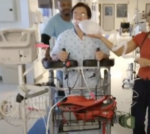The Halo Disinfection System is a cost-effective prevention strategy
Clostridium difficile, one of the most common and hard-to-treat healthcare-acquired infections (HAI), sickens nearly half a million people a year in the United States, according to the Centers for Disease Control and Prevention; 29,000 of them die from the disease contracted in hospitals or long-term care facilities.
C. diff also is hazardous to the financial health of health care institutions, insurers and society as a whole. A recent study published in the American Journal of Infection Control says C. diff pushes up hospital costs for infected patients an average of 40 percent per case, when compared to patients who do not acquire C. diffduring their hospital stays.
The study—titled Impact of Clostridium difficile-associated diarrhea on acute-care length of stay, hospital costs, and readmission—analyzed patients discharged between January 2009 and December 2011. Records for 171,586 patients discharged from about 500 U.S. hospitals in the Premier Healthcare Database were examined in a retrospective analysis. Researchers concluded that C. diff contributed to an increase of approximately 40 percent in costs per case, translating to an average of $7,285 in additional costs.
“Although it’s commonly known that C. diff contributes to high costs and less than ideal outcomes, this study is the first to provide a complete look at how much of an impact it has on U.S. hospitals and patients,” says Glenn Magee, MBA, lead author of the study and principal research scientist at Premier. “Efforts focused on preventing initial C. diff episodes, and targeted therapy to prevent recurrences for vulnerable patients, are essential to decrease this burden.”
We concur. In addition to more judicious management of antibiotics, effective disinfection is essential in preventing C. diff.
The Halo Disinfection System™ distributed by SPH Medical delivers hands-free, whole room surface disinfection with aerosolized hydrogen peroxide, resulting in a 6-log kill rate that dramatically reduces infections, saving money and lives. And, the price tag per patient room is surprisingly affordable.
So affordable that more than 350 patient rooms could be thoroughly disinfected for the equivalent of the additional cost involved in treating ONE SINGLE CASE of C. diff. That does not even take into account the very important goals of preventing human suffering and, in coming years, avoiding significant reimbursement payment penalties.
$7,285 vs. the cost of affordably disinfecting 350 rooms. Which choice would you want your hospital to make?


